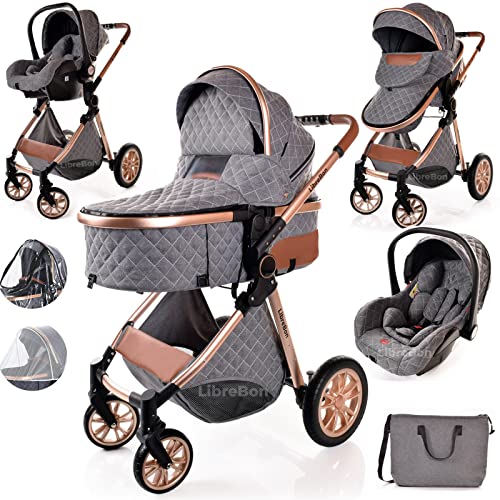10 Reasons Why People Hate Pushchair
Understanding Prams and Pushchairs: A Comprehensive Guide for Parents
When it concerns choosing the best mode of transportation for children, parents are frequently overwhelmed by the range of choices readily available. Prams and pushchairs are among the most typical options, and each has its own special features accommodating different needs. This article dives deep into the world of prams and pushchairs, detailing their differences, benefits, downsides, and suggestions for picking the best one for your household.
What is the Difference Between a Pram and a Pushchair?
Initially glance, prams and pushchairs may appear comparable, but they serve various functions based on a child's age and developmental stage. Below are the main differences:
Feature
Pram
Pushchair
Age Range
Usually for newborns approximately 6 months
Ideal for kids 6 months and older
Design
Flat, horizontal lying position for newborns
Upright seating position; more versatile and mobile
Use
Mostly for walking with babies
May include multiple seating choices and configurations
Foldability
Frequently bulkier and less portable
Typically light-weight and foldable for simple transportation
Types of Prams and Pushchairs
Picking the best pram or pushchair can depend upon different factors, consisting of the type, functions, and lifestyle of the family. Below are the main types of prams and pushchairs available in the market:
Prams
- Traditional Prams: Designed for newborns, they frequently include a deep and comfortable bassinet, making them ideal for young babies.
- Travel System Prams: These can shift from a bassinet to a toddler seat, often consisting of a baby cars and truck seat for ease of travel.
Pushchairs
- Requirement Pushchairs: Offer an upright seat and are suitable for older babies and young children. Pushchairs And Prams feature reclining abilities.
- Umbrella Pushchairs: Lightweight and highly portable, these designs fold compactly, making them ideal for travel.
- All-Terrain Pushchairs: Designed for rugged landscapes, they feature bigger wheels and exceptional suspension systems for off-road abilities.
Advantages and Disadvantages
Benefits of Prams
- Convenience for Newborns: Their flat, horizontal style is ideal for the healthy back advancement of babies.
- Stylish Designs: Many prams featured sophisticated aesthetics, interesting fashion-forward parents.
- Large: They tend to offer a bigger area for infants to move comfortably.
Drawbacks of Prams
- Bulkiness: They can be heavy and challenging to maneuver, making them less hassle-free for public transport or crowded areas.
- Cost: Prams typically include a greater price compared to pushchairs.
Benefits of Pushchairs
- Mobility: Many pushchairs fold compactly and are lightweight, providing amazing benefit for parents on the go.
- Adaptability: With numerous setups offered, pushchairs can match numerous phases of a kid's development.
- Easier to Store: Their smaller sized size makes them easier to store in compact areas.
Downsides of Pushchairs
- Less Comfort for Newborns: Most basic pushchairs are inappropriate for extremely young babies unless created with a reclining function.
- Resilience Concerns: Budget pushchairs may not stand up to substantial use compared to stronger pram designs.
Tips for Choosing the Right Pram or Pushchair
Choosing the right pram or pushchair needs mindful consideration. Here are some critical elements to bear in mind:
Age Appropriateness: Consider your kid's age. A pram may be preferable for a newborn, while a pushchair may be chosen for an older child.
Lifestyle Compatibility:
- If you often travel or use public transport, a lightweight choice may be easier.
- For active households who delight in outdoor activities, a tough, all-terrain pushchair might be beneficial.
Storage Needs:
- Think about where you'll keep the pram or pushchair, as some designs can take up considerable space.
Spending plan Constraints: Prams can be costly, particularly designer designs. Identify functions that are crucial to you before purchasing.
Safety Features: Always try to find essential security features like straps, brakes, and toughness when choosing a pram or pushchair.
FAQs
1. At what age can my baby start using a pushchair?
Many pushchairs are suitable for babies from six months, however some convertible designs can securely accommodate younger infants when utilized with a vehicle seat or bassinet attachment.
2. Can I take a pram or pushchair on public transportation?
The majority of public transport systems accommodate prams and pushchairs, but it's smart to inspect particular policy standards ahead of time.
3. How can I keep my pram or pushchair?
Regular cleaning, checking for wear and tear, and lubricating moving parts will assist in keeping your pram or pushchair's functionality and longevity.
4. Are travel systems worth the financial investment?
Travel systems can be a great investment for parents who regularly travel, providing an all-in-one service from vehicle to stroller. They offer convenience and ease of shift, specifically for new moms and dads.
5. Exist prams and pushchairs with additional features?
Yes, numerous modern designs come with features like cup holders, storage baskets, adjustable manages, canopies for sun shading, and even folding mechanisms that can be run with one hand.
Picking in between a pram and a pushchair is a decision that affects everyday parenting regimens. By understanding the differences, advantages, and ideal options, households can make informed choices that harmonize with their lifestyle requires. Whether it's a leisurely stroll in the park with a pram or a daring outing with an all-terrain pushchair, the very best choices typically lead to valued memories and satisfying experiences for both parents and children.
